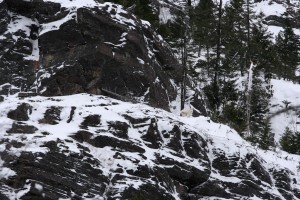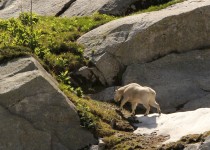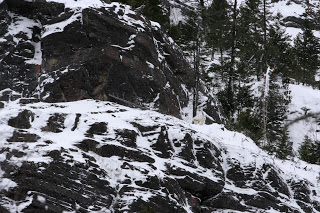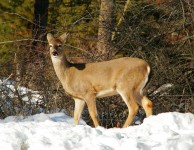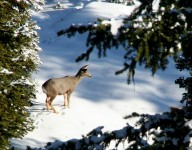The narrow ledges protruding from the sheer cliff caught enough snow to create a patchwork of white snow and dark rock that looked void of life especially during winter. But then movement caught my eye and I watched a cream-colored mountain goat move along a snow-covered ledge, proving that life could exist on the face of a cliff.
The unparalleled climbing ability of the mountain goat enables it to thrive in the seemingly inhospitable cliffs inaccessible to most animals and humans.
Their extraordinary climbing ability is attributed to specialized hoofs, massive shoulder muscles and a keen sense of balance. Their hooves have two toes with soft, padded soles that provide traction on wet and icy surfaces. While the sides of the hooves are rigid like other hoofed-animals, the hooves do not act like suction cups as many people believe.
Instead the flexible toes can spread apart wider than the hoof is long to distribute the goat’s grip over a large area and provide extra stability. Or the toes can be drawn together like pincers and grasp a knob of rock.
Their powerful shoulder muscles enable them to climb near vertical cliffs and leap between ledges while dewclaws on the rear of their ankles provides traction on steep descents. And their narrow stature allows them to edge along the tiniest ledges.
The steep cliffs goats thrive on can also be the source of their demise. While predators are usually the main cause of mortality in animals, they aren’t for mountain goats. Few predators can follow mountain goats into their rocky domain except for eagles that will swoop down and try to knock the mountain goats off ledges, especially the kids (young mountain goats).
While mountain goats may be agile mountaineers, one wrong step can lead to a fatal free-fall to the bottom of the cliff. However, the greatest mortality comes from avalanches and rockslides rumbling down the cliffs and sweeping mountain goats off ledges as they cascade to the valley below.
Winter is the most difficult time for mountain goats with the icy ledges, avalanches, cold temperatures and difficult access to food. The lush alpine meadows of summer are buried in snow and the mountain goats have to forage on what little vegetation exists on the snow-covered ledges. The mountain goats will climb to ground too steep or wind-swept to hold snow because that is where vegetation is exposed.
Mountain goats are able to survive winters in the harsh alpine environments (if they can find enough food) because of their thick winter coat. Next to their skin is a fluffy three-inch layer of cashmere-quality wool which is covered by a coarse layer of eight-inch long, hollow guard hairs. These winter coats allow them to endure winds as high as 100 miles per hour and temperatures as low as minus 50 degrees Fahrenheit as they forage on exposed ledges where vegetation also clings to existence.

